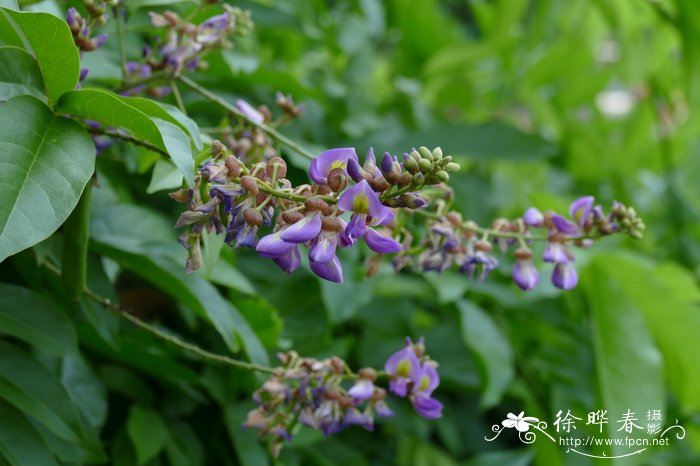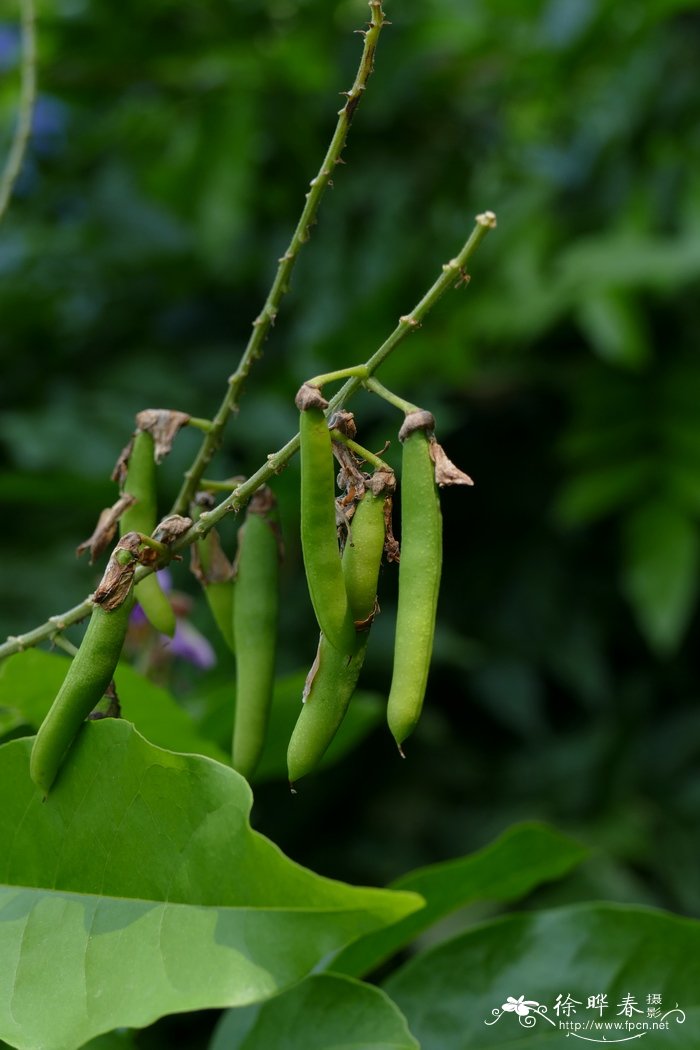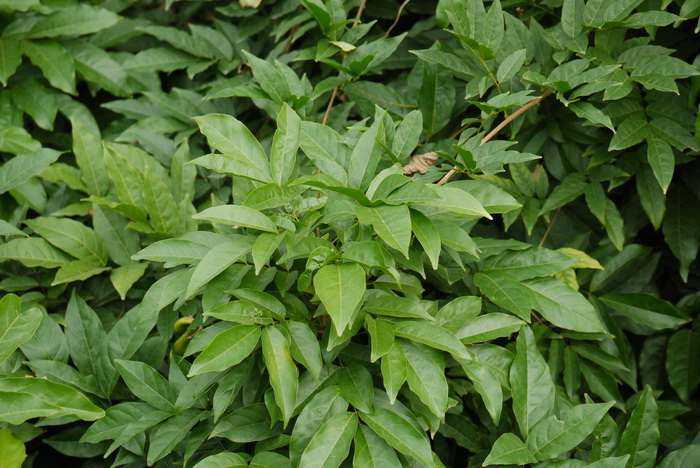喙果鸡血藤Callerya tsui
中文名(Chinese Name):喙果鸡血藤
学名(Scientific Name):Callerya tsui (F.P. Metcalf) Z. Wei & Pedley
英文名(English Common Name):
别名(Chinese Common Name):
异名(Synonym):Millettia tsui Metc.
科属(Family & Genus):蝶形花科鸡血藤属
形态特征(Description):
分布(Distribution):
用途(Use):
引自植物志英文版:FOC Vol. 10 Page 182, 184
Callerya tsui (F. P. Metcalf) Z. Wei & Pedley, Fl. China. 10: 184. 2010.
喙果鸡血藤 hui guo ji xue teng| Fabaceae | Callerya
Basionym: Millettia tsui F. P. Metcalf, Lingnan Sci. J. 19: 554. 1940.
Lianas, 3-10 m. Stems dark brown, terete, straight, fine ridged, brown tomentose, glabrescent, without lenticels. Leaves 3(or 5)-foliolate; rachis 12-28 cm, including petiole 5-8 cm; stipels absent; leaflet blades broadly elliptic to elliptic, (6-)10-18 × 5-8 cm, subleathery, both surfaces glabrous and shiny, reticulate veins prominent, base obtuse to broadly cuneate, apex rounded and with a cusp. Panicles terminal, 15-30 cm; flowering branchlets spreading, often leafy at base, brown tomentose, nodes congested. Flowers 1.5-2.5 cm. Corolla pale yellow flushed with red or lilac; standard oblong, without basal calluses, outside densely sericeous. Ovary stipitate, sericeous, with 4-7 ovules. Legume ellipsoid when 1-seeded and ca. 5.5 × 4 cm, linear-oblong when 2- or 3-seeded and ca. 7 × 3 cm, inflated but contracted between seeds, brown tomentose but generally glabrescent, base tapering to 5 mm stipe, apex with a hard hooked beak. Seeds 1-3 per legume, dark brown, subglobose to oblately spheroid, 2-2.5 × 1-2.5 cm. Fl. Jul-Sep, fr. Oct-Dec.
● Thickets, woodlands in valleys; 200-1600 m. Guangdong, Guangxi, S Guizhou, Hainan, S Hunan, S Yunnan.
The stem and root are used medicinally. The bast fibers are rather tough and used for making rope. The seeds are edible after stewing.


 (责任编辑:徐晔春)
(责任编辑:徐晔春)
学名(Scientific Name):Callerya tsui (F.P. Metcalf) Z. Wei & Pedley
英文名(English Common Name):
别名(Chinese Common Name):
异名(Synonym):Millettia tsui Metc.
科属(Family & Genus):蝶形花科鸡血藤属
形态特征(Description):
分布(Distribution):
用途(Use):
引自植物志英文版:FOC Vol. 10 Page 182, 184
Callerya tsui (F. P. Metcalf) Z. Wei & Pedley, Fl. China. 10: 184. 2010.
喙果鸡血藤 hui guo ji xue teng| Fabaceae | Callerya
Basionym: Millettia tsui F. P. Metcalf, Lingnan Sci. J. 19: 554. 1940.
Lianas, 3-10 m. Stems dark brown, terete, straight, fine ridged, brown tomentose, glabrescent, without lenticels. Leaves 3(or 5)-foliolate; rachis 12-28 cm, including petiole 5-8 cm; stipels absent; leaflet blades broadly elliptic to elliptic, (6-)10-18 × 5-8 cm, subleathery, both surfaces glabrous and shiny, reticulate veins prominent, base obtuse to broadly cuneate, apex rounded and with a cusp. Panicles terminal, 15-30 cm; flowering branchlets spreading, often leafy at base, brown tomentose, nodes congested. Flowers 1.5-2.5 cm. Corolla pale yellow flushed with red or lilac; standard oblong, without basal calluses, outside densely sericeous. Ovary stipitate, sericeous, with 4-7 ovules. Legume ellipsoid when 1-seeded and ca. 5.5 × 4 cm, linear-oblong when 2- or 3-seeded and ca. 7 × 3 cm, inflated but contracted between seeds, brown tomentose but generally glabrescent, base tapering to 5 mm stipe, apex with a hard hooked beak. Seeds 1-3 per legume, dark brown, subglobose to oblately spheroid, 2-2.5 × 1-2.5 cm. Fl. Jul-Sep, fr. Oct-Dec.
● Thickets, woodlands in valleys; 200-1600 m. Guangdong, Guangxi, S Guizhou, Hainan, S Hunan, S Yunnan.
The stem and root are used medicinally. The bast fibers are rather tough and used for making rope. The seeds are edible after stewing.
踩一下[0]

顶一下[1]